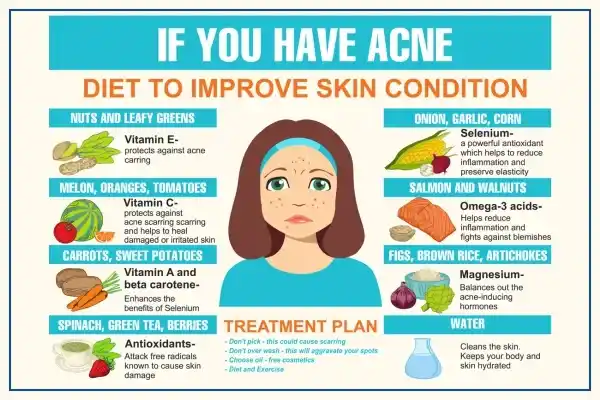How To Get Rid Of Acne
Acne vulgaris or acne is a disease of the hair follicles of the face, chest, and back, which will affect almost all teenagers during puberty. Bacteria do not cause this, but bacteria play a vital role in their development. Acne vulgaris is typical teenage acne that is characterized by three types of lesions:
- The comedo or blackheadInflammatory papule
- Inflammatory papule
- pustule and pimple
Acne appears on the skin as:
- Blackheads or whiteheads
- Pimples
- Pustules
- Cysts
Symptoms
Acne can be identified almost everywhere in the body. It most frequently happens on the face, back, neck, chest, and shoulders. If you already have acne, you’ll start noticing white or black pills. Blackheads and whiteheads are recognized as erythema. Blackheads open on the surface of the skin, providing them with a black appearance due to oxygen in the atmosphere. Whiteheads are closed down just under the surface of the skin, which gives a white appearance.
While inflammatory acne and blackheads are perhaps the most prevalent lesions seen in acne, those certain types also may occur. Inflammation lesions are more prone to happen skin scarring. It includes:
- Papules
- Pustules
- Nodules
- Cysts
Types of Acne
Blackheads
Open bumps on the skin that load up with excess oil and dead cells. They look like dirt has accumulated in the bump, but perhaps the deficient in essentials is caused by an abnormal light that is reflected from the clogged follicle.
Whiteheads
Bumps which is remained closed by oil and dead skin.
Papules
Small red or pink bumps which become inflamed.
Pustules
Pimples that contain pus. They look something like whiteheads surrounded by red rings. They can cause some serious reaction if they are scratched.
Fungal Acne
This type occurs when an excess of yeast develops in the hair follicles. It can become itchy and inflamed.
Nodules
It’s a solid pimple that is present deep inside the skin. They are large and very painful.
Cysts
Pus-filled pimples will cause scars on your skin.
Causes
Acne occurs whenever the pores of your skin are blocked by oil, dead cells, or bacteria. Each pore of your skin is indeed a follicle opening. The cyst consists of hair and a sebaceous (oil) gland. The oil gland releases sebum (oil) that travels through your hair, through your pore, and through your skin. The sebum helps keep your skin smooth and hydrated.
One or even more issues can affect acne in this lubrication process. It may occur when:
- Too many oils are being produced by your follicles
- Dead skin cells build up in your pores
- Build the bacteria in your pores
These major issues contribute to the development of the pipes. The pineapple appears when the bacteria multiply in the clogged pore, as well as the oil cannot flee.
Other triggers that can cause Acne are:
- Greasy cosmetics
- Hormonal changes
- Emotional stress
- Menstruation
Risk factors
Some myths contribute to the formation of acne. Many people have false people that food like chocolate or French fries can contribute to acne. While there is very little specific support for these claims. There are certain risk factors that developed are:
- Hormonal changes which are caused by puberty or pregnancy
- Medication, which includes birth control pills or corticosteroids
- A high diet such as bread and chips, which have a high amount of carbohydrates and sugar
Treatment
Home care treatment:
Some health care activities that can help in the treatment of acne are:
- Cleanse your skin daily with mild soap to remove the excess dirt and oils.
- Rinse your hair regularly to keep it out of your face
- Use makeup that is liquid or labeled “non-comedogenic” (not pore-clogging)
- Do not squeeze or pick pimples that spread bacteria and clogged pores.
- Do not wear hats or tight headbands
- Don’t touch your face

Medication:
If self-care doesn’t help with one’s acne, there are a few over-the-counter acne treatment options. Many of these medicines contain chemicals that can help kill the bacteria or decrease the oil to the skin. These include the following:
- Benzoyl Peroxide
- Sulfur
- Resorcinol
- Salicylic Acid
Preventions
It’s difficult to prevent acne. But some prevention steps can be taken to prevent acne:
- Wash your face twice a day with an oil-free cleanser
- Use over-the-counter acne cream to remove unwanted oil
- Avoiding makeup containing oil
- Remove the makeup and clean your skin thoroughly before bedtime.
- Taking a shower after exercise
- Avoiding tight clothing
- Eating healthy with low refined sugar
- Reduction of stress
How to get rid of pimples?
Lifestyle
Moderation and consistency are good things, but not everybody can sleep for 8 hours, eat three healthy meals a day, and drink lots of fluids a day. Probably the most interesting lifestyle change you can make is never to select or pull the pills. Playing with or bursting pimples, no matter how smart and clean one is, often keeps the bumps red and bumpier longer.
Cleansing and Skincare
Even after what one could read in specific trends and fashion magazines, there’s no magic product or regimen which is right per each individual and every scenario.
- Mild Cleansers: Wash your face with a cleanser once or twice a day for keeping your skin oil-free.
- Exfoliating cleansers: Exfoliating cleansers should be used for removing the outer layer of the skin and opening the pores.
Reducing Bacteria
- Antibacterial cleansers: Use benzoyl peroxide as it works as an antibacterial cream.
- Topical creams: Antibacterial cream comes as gels, creams, and lotions which are applied In the affected area.

